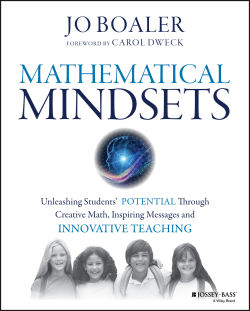The excerpt below is from the book "Mathematical Mindsets: Unleashing Students' Potential Through Creative Math, Inspiring Messages and Innovative Teaching," by Jo Boaler. This excerpt is from the chapter entitled “Teaching Mathematics for a Growth Mindset.”
Believe in All of Your Students
I have always known how important it is that students know their teacher believes in them; I knew this as a teacher and more recently became more acutely aware of it as a parent. When my daughter was five, she realized the teacher of her class in England was giving other students harder math problems, and she came home to me and asked why. When she realized that the teacher did not think she had potential—and sadly, this was true; the teacher had decided she had limited ability—her self-belief was shattered, and she developed a terribly fixed mindset that damaged her learning and confidence for a long time afterward. Now, some years later, after a lot of work from her parents and some wonderful teachers, she is transformed: she has a growth mindset and loves math. Despite the fact that the teacher never said to my daughter that she did not believe in her, she managed to communicate that message loud and clear, and this was understood by my daughter even at the young age of five.
The school that my daughter attended in England put students into ability groups in second grade, but they stopped this practice after reading the research evidence and learning about the strategies for teaching heterogeneous groups. After they made this change, the principal wrote to tell me it had transformed math classes and raised achievement across the school. If students are placed into ability groups, even if they have innocuous names such as the red and blue groups, students will know, and their mindsets will become more fixed. When children were put into ability groups in my daughter’s school, children from the lower groups came home saying “All the clever children have gone into another group now.” The messages the students received about their potential as learners in general (not just about math) were devastating for them. One of the first steps we need to take, as a nation, is to move away from outdated methods of fixed mindset grouping and communicate to all students that they can achieve.

The importance of students thinking their teacher believes in them was confirmed in a recent study that had an extremely powerful result (Cohen & Garcia, 2014). Hundreds of students were involved in this experimental study of high school English classes. All of the students wrote essays and received critical diagnostic feedback from their teachers, but half the students received a single extra sentence on the bottom of the feedback. The students who received the extra sentence achieved at significantly higher levels a year later, even though the teachers did not know who received the sentence and there were no other differences between the groups. It may seem incredible that one sentence could change students’ learning trajectories to the extent that they achieve at higher levels a year later, with no other change, but this was the extra sentence:



